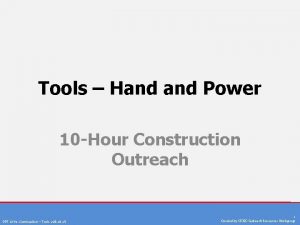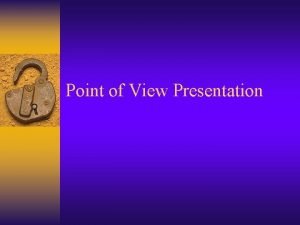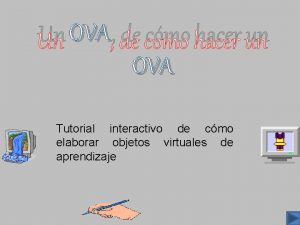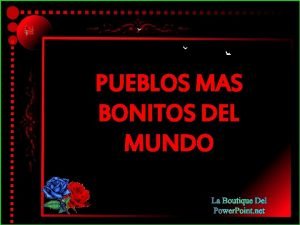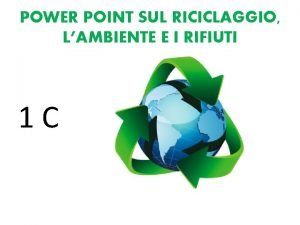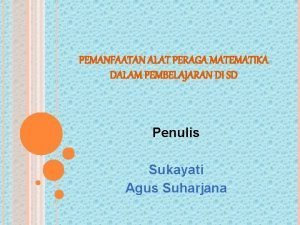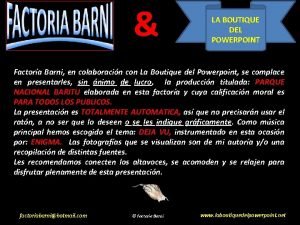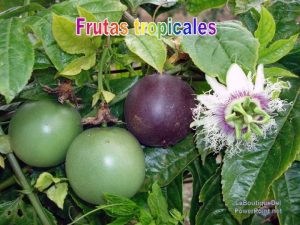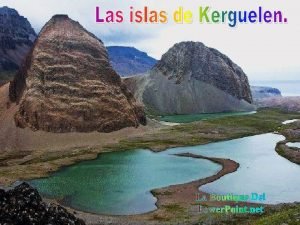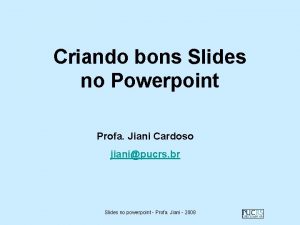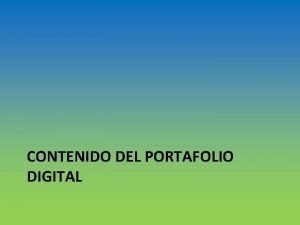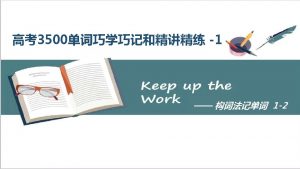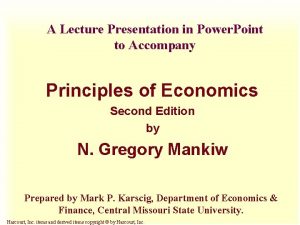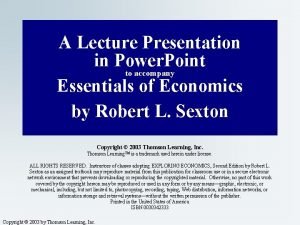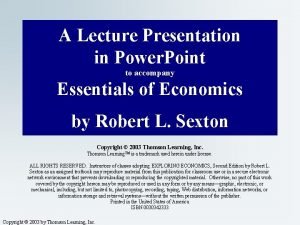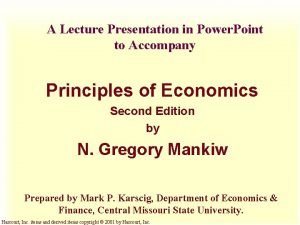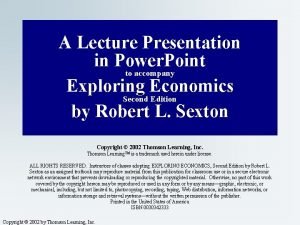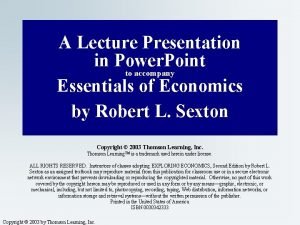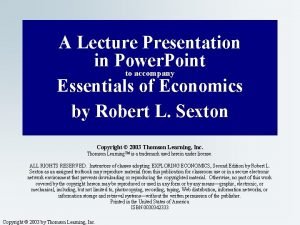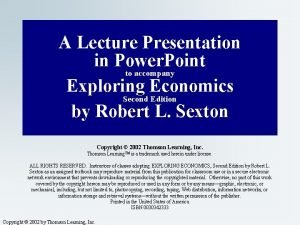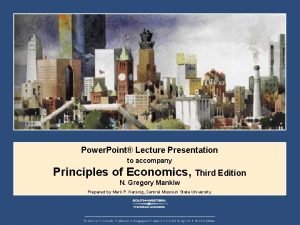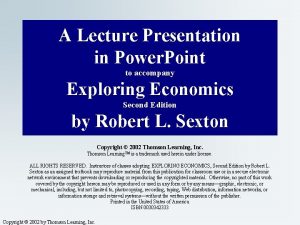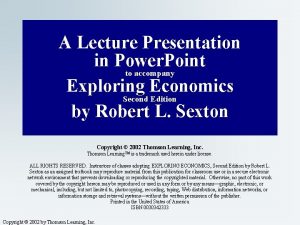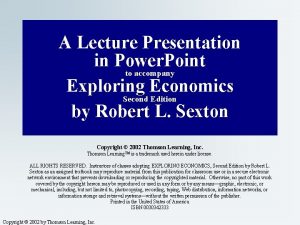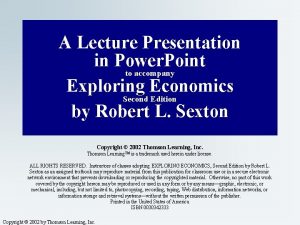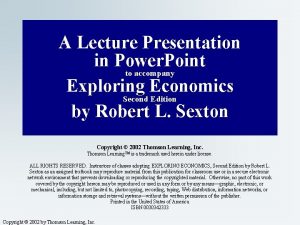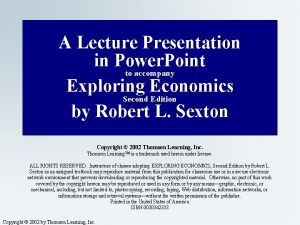A Lecture Presentation in Power Point to accompany













































- Slides: 45

A Lecture Presentation in Power. Point to accompany Essentials of Economics Second Edition by Robert L. Sexton Copyright © 2003 Thomson Learning, Inc. Thomson Learning™ is a trademark used herein under license. ALL RIGHTS RESERVED. Instructors of classes adopting EXPLORING ECONOMICS, Second Edition by Robert L. Sexton as an assigned textbook may reproduce material from this publication for classroom use or in a secure electronic network environment that prevents downloading or reproducing the copyrighted material. Otherwise, no part of this work covered by the copyright hereon may be reproduced or used in any form or by any means—graphic, electronic, or mechanical, including, but not limited to, photocopying, recording, taping, Web distribution, information networks, or information storage and retrieval systems—without the written permission of the publisher. Printed in the United States of America ISBN 0030342333 Copyright © 2003 by Thomson Learning, Inc.

Chapter 3 Scarcity, Trade-Offs and Economic Growth Copyright © 2003 by Thomson Learning, Inc.

3. 1 The Three Economic Questions Every Society Faces n n Because of scarcity, certain economic questions must be answered regardless of the level of affluence of the society or its political structure. Three fundamental questions that inevitably must be faced in a world of scarcity are: What is to be produced? n How are these goods to be produced? n For whom are the goods produced? n Copyright © 2003 by Thomson Learning, Inc.

3. 1 The Three Economic Questions Every Society Faces n n n In market-oriented economies, people “vote” with their dollars. Consumer sovereignty describes how individual consumers in market economies determine what is to be produced. Market economies largely rely on a decentralized decision-making process, in which literally millions of individual producers and consumers of goods and services determine what goods will be produced Copyright © 2003 by Thomson Learning, Inc.

n n n Economies are organized in different ways to answer the question of what is to be produced. Command economies rely on central planning, where decisions about what is produced is largely determined by a government official or a committee associated with the central planning organization. Most countries, including the United States, have mixed economies in which the government and private sector together determine the allocation of resources. Copyright © 2003 by Thomson Learning, Inc.

Exhibit 1: Government Spending as a Percentage of GDP 70 Canada 60 German 50 y Sweden United S tate s France Japan 40 30 20 United K ingdom 10 0 % OF G DP, 192 0 Copyright © 2003 by Thomson Learning, Inc. % OF G DP, 199 8

3. 1 The Three Economic Questions Every Society Faces n n All economies, regardless of political structure, must decide how, from several possible ways, to produce the goods and services that they want. For example, when digging a ditch, a contractor must decide between many workers using their hands, a few workers with shovels, or one person with a backhoe. A decision must be made as to which method is appropriate. The best method is the least-cost method. Copyright © 2003 by Thomson Learning, Inc.

3. 1 The Three Economic Questions Every Society Faces n n n The best or "optimal" form of production will vary from one economy to the next. Each nation tends to use the production processes that conserve its relatively scarce (and thus relatively more expensive) resources and use more of its relatively abundant resources. Labor intensive methods will be used where capital is relatively scarce and capital intensive methods will be used where labor is relatively scarce. Copyright © 2003 by Thomson Learning, Inc.

3. 1 The Three Economic Questions Every Society Faces n In every society, some mechanism must exist to determine how goods and services are to be distributed among the population. Who gets what? n The distribution of income is an issue that always arouses strong emotional responses. n Copyright © 2003 by Thomson Learning, Inc.

3. 1 The Three Economic Questions Every Society Faces n n In a market economy, the amount of output one is able to obtain depends on one's income, which in turn, depends on the quantity and quality of the scarce resources that the individual controls. For example, Tiger Woods' income is very large because his skills are unique and marketable. Copyright © 2003 by Thomson Learning, Inc.

Why do actors make so much money? Copyright © 2003 by Thomson Learning, Inc.

3. 2 The Circular Flow Model n Goods and services bought and sold flow continuously between the producers of goods and services (firms), and the buyers of goods and services (households). Copyright © 2003 by Thomson Learning, Inc.

3. 2 The Circular Flow Model n n Income also flows continuously from firms to households as firms buy the inputs to produce the goods and services they sell. These exchanges take place in product markets and factor markets. Copyright © 2003 by Thomson Learning, Inc.

3. 2 The Circular Flow Model n Product markets n n n the markets for consumer goods and services Households buy and firms sell. Payments for purchases flow to firms at the same time that goods and services flow to households. Copyright © 2003 by Thomson Learning, Inc.

3. 2 The Circular Flow Model n Factor or input markets n the markets where households sell their factors of production to firms. capital n land n labor n entrepreneurship n n Households receive money payments from firms as compensation. Copyright © 2003 by Thomson Learning, Inc.

3. 2 The Circular Flow Model n Circular flow model of income and output n n Illustrates the continuous flow of goods and payments between firms and households, with the product market on the top half and the factor or input markets on the bottom half. However, the main point is that buyers have sellers. Copyright © 2003 by Thomson Learning, Inc.

The Circular Flow Model of Income and Output Spending ($) (=GDP) Revenues ($) (=GDP) Product Markets Goods and Services Purchased Goods and Services Sold Flows of Goods and Services Firms Households Flows of Dollars Labor, Land, Capital and Entrepreneurship Inputs for Production Factor Markets Income ($) (=GDP) Copyright © 2003 by Thomson Learning, Inc. Wages, Rent, Interest and Profits ($) (=GDP)

3. 3 The Production Possibilities Curve n n The economic concepts of scarcity, choice and trade-offs can be illustrated by the use of a production possibilities curve, which represents the potential total output combinations of any two goods for an economy. That is, it illustrates an economy's potential for allocating its limited resources for producing various combinations of goods, in a given time period. Copyright © 2003 by Thomson Learning, Inc.

3. 3 The Production Possibilities Curve n The production possibilities curve discussion begins with a straight-line production possibilities curve, with the goods being one's grade in economics and one's grade in history. Copyright © 2003 by Thomson Learning, Inc.

Expected Grade in Economics Exhibit 1: Production Possibilities Curve: "Producing" Grades in Economics and History A 95 10 Hours Economics 0 Hours History 7. 5 Hours Economics 2. 5 Hours History B 85 5 Hours Economics 5 Hours History C 75 2. 5 Hours Economics 7. 5 Hours History D 65 F 55 55 F 0 Hours Economics 10 Hours History 65 75 85 95 D C B A Expected Grade in History Copyright © 2003 by Thomson Learning, Inc.

3. 3 The Production Possibilities Curve n On a production possibilities curve, we assume that the economy has a given quantity and quality of resources and technology available to use for production. Copyright © 2003 by Thomson Learning, Inc.

3. 3 The Production Possibilities Curve n n Using an example involving food and shelter we can see a concave (bowed) production possibilities curve. Each point represents the potential amounts of food and shelter that can be produced in a given time period, given the quantity and quality of resources available. Copyright © 2003 by Thomson Learning, Inc.

Shelter (units) Exhibit 2: Production Possibilities Curve: The Trade-Off Between Shelter and Food 10 A 9 8 7 6 5 4 3 2 1 0 B N (Not Attainable) C I (Inefficient) 20 the points on the production possiblilities curve are efficient. D 40 60 Food (units) n Any n All n Any E 80 points in the shaded area are inefficient. point outside the production possibilities curve is not attainable at the present time. Copyright © 2003 by Thomson Learning, Inc.

3. 3 The Production Possibilities Curve n n The economy cannot produce beyond the levels indicated by the production possibilities curve during a given time period, because there are not enough resources to produce that output. However, it is possible to operate inside the production possibilities curve. Copyright © 2003 by Thomson Learning, Inc.

3. 3 The Production Possibilities Curve n n If an economy is operating inside its production possibilities curve, it is not at full capacity, and is operating inefficiently. The economy is not getting the most it can from its scarce resources; as a result, actual output is less than potential output. Copyright © 2003 by Thomson Learning, Inc.

3. 3 The Production Possibilities Curve n n Efficiency requires society to use its resources to the fullest extent—getting the most we can out of our scarce resources; that is, there are no wasted resources. If resources are being used efficiently, at a point along a production possibilities curve, more of one good or service requires the sacrifice of another good or service as its cost. Copyright © 2003 by Thomson Learning, Inc.

3. 3 The Production Possibilities Curve n n Efficiency does not tell us which point along the production possibilities curve is best. But it does tell us that points inside the curve cannot be best because some resources are wasted. Copyright © 2003 by Thomson Learning, Inc.

3. 3 The Production Possibilities Curve n n The production possibilities curve is not a straight line. It is concave from below (that is, bowed outward from the origin), reflecting increasing opportunity costs of producing additional amounts of a good. Copyright © 2003 by Thomson Learning, Inc.

Shelter (unit) Exhibit 3: Increasing Opportunity Cost and the Production Possibilities Curve 10 9 8 7 6 5 4 3 2 1 A Opportunity cost in forgone shelter (1) to obtain 20 additional food 0 Copyright © 2003 by Thomson Learning, Inc. B Opportunity cost in forgone shelter (2) to obtain 20 additional food C Opportunity cost in forgone shelter (3) to obtain 20 additional food D Opportunity cost in forgone shelter (4) to obtain 20 additional food E 20 40 60 Food (units) 80

3. 3 The Production Possibilities Curve n n The basic reason for increasing opportunity cost is that some resources and skills cannot be easily adapted from their current uses to alternative uses. Easily adaptable resources are soon exhausted and resources and workers that are less well suited or appropriate (those with a relatively greater opportunity cost) must then be employed to increase output further. Copyright © 2003 by Thomson Learning, Inc.

Exhibit 4: Opportunity Costs for Cattle and Wheat Quantity of Cattle A B 50 C 45 Opportunity cost 40 D in forgone cattle 35 (25) to obtain 10 30 E additional 25 bushels of wheat 20 15 10 F 5 0 5 10 15 20 25 30 35 40 45 50 Quantity of Wheat (bushels) Copyright © 2003 by Thomson Learning, Inc.

3. 4 Economic Growth and the Production Possibilities Curve n n To generate economic growth, a society must produce fewer consumer goods and more capital goods in the present. They must sacrifice some consumption of consumer goods in the present in order to experience growth in the future. Copyright © 2003 by Thomson Learning, Inc.

3. 4 Economic Growth and the Production Possibilities Curve n n Investing in capital goods will increase the future production capacity of the economy. So an economy that invests more and consumes less now will be able to produce and consume more in the future. Copyright © 2003 by Thomson Learning, Inc.

3. 4 Economic Growth and the Production Possibilities Curve n n An economy can only grow with qualitative or quantitative changes in the factors of production–land, labor, capital and entrepreneurship. Advancements in technology, improvements in labor productivity or new natural resource finds could all lead to outward shifts of the production possibilities curve. Copyright © 2003 by Thomson Learning, Inc.

3. 4 Economic Growth and the Production Possibilities Curve n n Economic growth means an outward shift in the “menu” of possible bundles of output illustrated by the production possibilities curve. With growth comes the possibility to have more of both goods than were previously available. Copyright © 2003 by Thomson Learning, Inc.

Shelter (unit) Exhibit 1: Economic Growth and Production Possibilities 18 16 14 12 A 10 B 9 8 C 7 6 Old 5 production 4 3 possibilties 2 curve New production possibilties curve F (FUTURE) D 1 0 E 20 40 60 80 Food (units) Copyright © 2003 by Thomson Learning, Inc. 100 120

3. 4 Economic Growth and the Production Possibilities Curve n n n It is important to remember that increases in a society's output do not make scarcity disappear. Even when output has grown more rapidly than population, so people are made better off, they still face trade-offs. At any point along the production possibilities curve, in order to get more of one thing, you must give up something else. Copyright © 2003 by Thomson Learning, Inc.

3. 4 Economic Growth and the Production Possibilities Curve n n An economy that invests more of its resources for the future devotes a larger share of its productive capacity to capital goods rather than consumption goods. Economies that choose to invest more of their resources for the future will grow faster than those that don't, other things equal. Copyright © 2003 by Thomson Learning, Inc.

Exhibit 2: Economic Growth and the Production Possibilities Curve Capital Goods (K) Economy (A) 2012 KA 2002 CA Consumer Goods (C) Copyright © 2003 by Thomson Learning, Inc.

Exhibit 2: Economic Growth and the Production Possibilities Curve Capital Goods (K) Economy (B) 2012 2002 KB Copyright © 2003 by Thomson Learning, Inc. CB Consumer Goods (C)

3. 4 Economic Growth and the Production Possibilities Curve n n The production possibilities curve can be used to illustrate the economic concepts of scarcity, choice, opportunity costs, efficiency, and economic growth. Scarcity is represented by the fact that resource combinations outside the production possibility curve are unattainable. Copyright © 2003 by Thomson Learning, Inc.

3. 4 Economic Growth and the Production Possibilities Curve n n Choice is the fact that one must choose among the alternative bundles available along the production possibilities curve. Opportunity costs are how much of one good you give up to get another unit of the second good as you move along the production possibilities curve. Copyright © 2003 by Thomson Learning, Inc.

3. 4 Economic Growth and the Production Possibilities Curve n n Efficiency would mean being on the production possibilities curve rather than inside it. Economic growth is represented by shifting out the production possibilities curve. Copyright © 2003 by Thomson Learning, Inc.

Quantity of Military Goods Exhibit 3: Production Possibilities Curve Economic growth D C B A 0 Quantity of Consumer Goods Copyright © 2003 by Thomson Learning, Inc.

Average Annual per Capita Real GDP Growth Rate (1970– 90) Exhibit 4: Correlation of Investment and Growth 4. 0 Irelan d 3. 5 3. 0 2. 5 2. 0 1. 5 1. 0 Japa n Icelan d Portugal Finlan d Austria Norwa y Turke Canad Italy y Belgium a Greec Spai n United German e Luxembourg Kingdom y Franc Australi e Denmark Netherlands a Sweden United Switzerlan States New Zealand d 0. 5 0. 0 16 18 20 22 24 26 28 Investment as Share of GDP (average, 1970 -1990) Copyright © 2003 by Thomson Learning, Inc. 30 32
 Things that accompany salvation
Things that accompany salvation Accompany chapter 1
Accompany chapter 1 Cephalic vein in hand
Cephalic vein in hand Inkjet printers are considered legacy technology
Inkjet printers are considered legacy technology 01:640:244 lecture notes - lecture 15: plat, idah, farad
01:640:244 lecture notes - lecture 15: plat, idah, farad Presentation in hindi topic
Presentation in hindi topic Power point presentation design west vancouver
Power point presentation design west vancouver Power triangle diagram
Power triangle diagram Power bi training powerpoint
Power bi training powerpoint Point point power
Point point power Lecture presentation software
Lecture presentation software Power system dynamics and stability lecture notes
Power system dynamics and stability lecture notes Power system analysis lecture notes
Power system analysis lecture notes Power semiconductor devices lecture notes
Power semiconductor devices lecture notes Switch mode power supply lecture notes
Switch mode power supply lecture notes Power system dynamics and stability lecture notes
Power system dynamics and stability lecture notes Customs in things fall apart
Customs in things fall apart Fetal lie
Fetal lie 4 maneuvers of leopold
4 maneuvers of leopold Osha hand and power tools powerpoint
Osha hand and power tools powerpoint Point of view presentation
Point of view presentation The starting point in a presentation
The starting point in a presentation Solar power satellites and microwave power transmission
Solar power satellites and microwave power transmission Potential power
Potential power Flex28024a
Flex28024a Unit of dispersive power
Unit of dispersive power Power of a power property
Power of a power property General power rule vs power rule
General power rule vs power rule Power angle curve in power system stability
Power angle curve in power system stability Power delivered vs power absorbed
Power delivered vs power absorbed Evangelio del domingo en power point
Evangelio del domingo en power point Aplausos sonido
Aplausos sonido La boutique del powerpointx
La boutique del powerpointx Tennis power point
Tennis power point Powerpoint turing machine
Powerpoint turing machine Powerpoint sul riciclo
Powerpoint sul riciclo Fungsi blok dienes
Fungsi blok dienes Powerpoint sekolah sabat
Powerpoint sekolah sabat Laboutiquedelpowerpoint x
Laboutiquedelpowerpoint x La boutique del power point
La boutique del power point La boutique del power point
La boutique del power point La boutique del power point
La boutique del power point Animasi terima kasih power point bergerak
Animasi terima kasih power point bergerak Decreto 1330 de 2019 power point
Decreto 1330 de 2019 power point Conclusão apresentação power point
Conclusão apresentação power point Portafolio digital estudiantil ejemplo
Portafolio digital estudiantil ejemplo



















